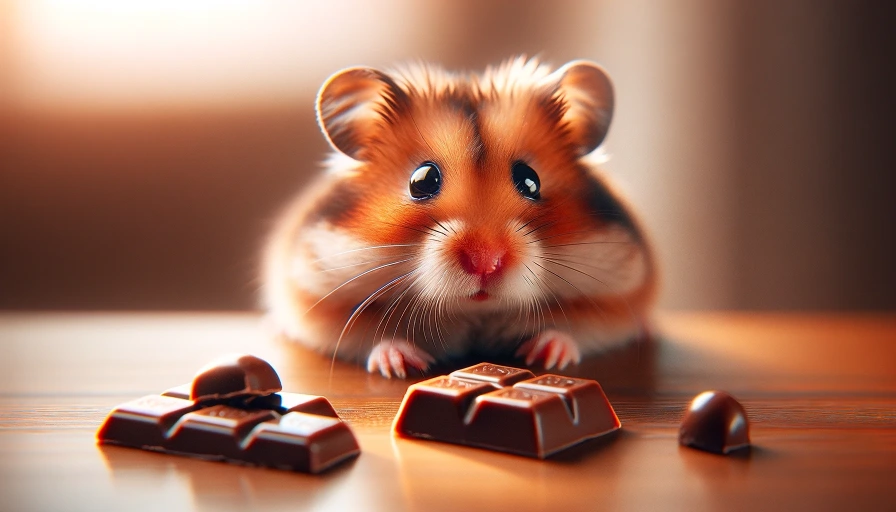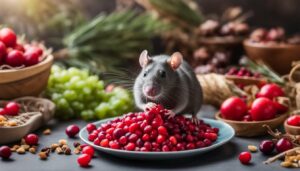Hamsters are adorable and curious little creatures, making them popular pets in households around the world.
As a responsible pet owner, it’s crucial to understand the dietary needs of your hamster to ensure their health and well-being.
While it might be tempting to share your favorite snacks with your furry friend, not all human foods are safe for hamsters.
One common question that arises is whether hamsters can eat chocolate. In this article, we will explore the dietary requirements of hamsters, the dangers of chocolate consumption, and provide safe treat alternatives to keep your pet happy and healthy.
Understanding what foods are safe and which are harmful is essential for any hamster owner.
Why Diet is Crucial for Hamsters
A balanced and nutritious diet is fundamental to the health and well-being of hamsters. These small animals have specific dietary needs that must be met to ensure they live long, healthy lives.
Hamsters, like all pets, rely on their owners to provide them with appropriate food that meets their nutritional requirements.
Hamsters require a diet that is rich in fiber and low in fat and sugar. Their natural diet in the wild consists of seeds, grains, fruits, and vegetables, which provide them with the essential nutrients they need.
A balanced diet helps to maintain their digestive health, supports their immune system, and ensures they have the energy necessary for their daily activities.
One of the key components of a hamster’s diet is fiber, which is crucial for maintaining a healthy digestive system. A lack of fiber can lead to digestive issues such as constipation or diarrhea.
Additionally, hamsters need a good source of protein to support their muscle development and overall growth.
This is typically provided through specially formulated hamster pellets or commercial hamster food.
It is also important to be mindful of the foods that hamsters should avoid. Certain foods can be toxic or harmful to them, leading to serious health problems or even death.
For instance, foods high in sugar or fat can contribute to obesity and related health issues, while certain fruits and vegetables might cause digestive distress.
Overall, understanding the importance of a proper diet for hamsters is essential for any pet owner.
By providing a balanced and varied diet, you can help ensure that your hamster remains healthy, active, and happy.
In the following sections, we will delve deeper into specific foods that are harmful to hamsters, with a particular focus on the dangers of chocolate.
The Dangers of Chocolate for Hamsters
Chocolate, a beloved treat for many humans, poses significant risks to hamsters.
This popular snack contains several substances that are toxic to small animals, making it extremely dangerous for hamsters to consume.
Understanding these dangers is crucial for any hamster owner to prevent accidental poisoning and ensure their pet’s safety.
Overview of Chocolate Toxicity in Animals
Chocolate, a beloved treat for many humans, poses significant risks to hamsters. This popular snack contains several substances that are toxic to small animals, making it extremely dangerous for hamsters to consume. Understanding these dangers is crucial for any hamster owner to prevent accidental poisoning and ensure their pet’s safety.
Specific Toxins in Chocolate
Effects of These Toxins on Small Animals
- Theobromine: This compound is the primary toxin in chocolate that causes problems for hamsters. Theobromine affects the nervous system and can lead to hyperactivity, increased heart rate, and muscle tremors. In severe cases, it can cause seizures, coma, and even death.
. - Caffeine: Similar to theobromine, caffeine is also a stimulant that can have harmful effects on hamsters. It can cause restlessness, rapid breathing, and heart palpitations. The combination of theobromine and caffeine amplifies the toxic effects on hamsters.
Understanding Theobromine Poisoning
Theobromine is a bitter alkaloid found in chocolate and is the primary reason why chocolate is toxic to hamsters.
Hamsters are particularly sensitive to theobromine due to their small size and slow metabolism of this compound.
The symptoms of theobromine poisoning can appear within a few hours of ingestion and can escalate rapidly.
Symptoms of Theobromine Poisoning in Hamsters
- Restlessness and hyperactivity
- Increased heart rate
- Tremors and muscle twitching
- Diarrhea and vomiting
- Severe cases: seizures, coma, and death
Comparison with Other Animals
While chocolate is also toxic to dogs and cats, the effects on hamsters can be even more severe due to their smaller size.
Even a tiny amount of chocolate that might seem negligible can be fatal for a hamster. Therefore, it is crucial to ensure that chocolate and any food containing chocolate are kept far out of reach of your hamster.
In summary, chocolate poses a serious threat to hamsters due to the presence of theobromine and caffeine.
These compounds can cause severe and potentially fatal health issues in hamsters. As a responsible pet owner, it is essential to be aware of these dangers and prevent your hamster from having any access to chocolate.
In the next section, we will discuss the specific signs of chocolate poisoning in hamsters and what steps to take if your hamster accidentally consumes chocolate.
The Role of Caffeine in Chocolate
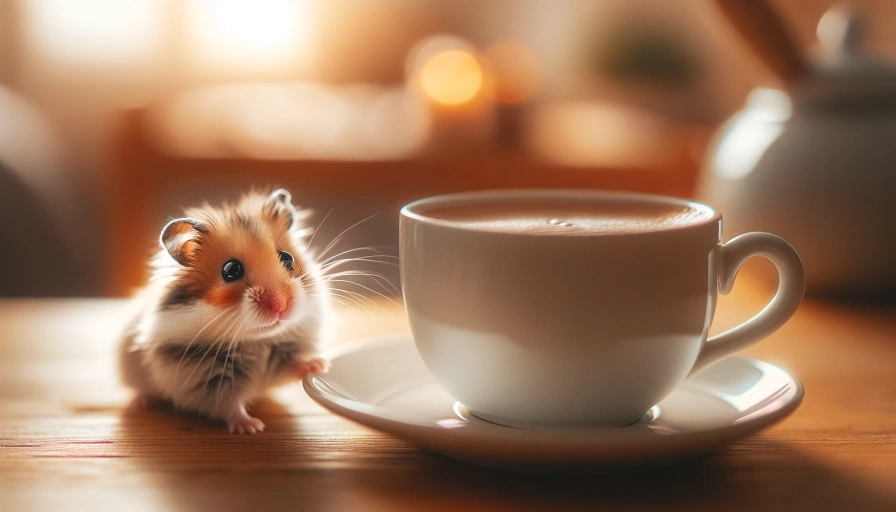
How Caffeine Affects Hamsters
Caffeine, a well-known stimulant found in chocolate, can have significant adverse effects on hamsters.
While caffeine is commonly consumed by humans for its stimulating effects, it poses a serious threat to small animals like hamsters.
Due to their small size and different metabolic rates, hamsters are much more sensitive to caffeine.
When ingested, caffeine can rapidly affect their central nervous system and cardiovascular system.
Symptoms of Caffeine Poisoning
When a hamster ingests chocolate containing caffeine, it can exhibit a range of symptoms indicative of poisoning.
These symptoms can appear quickly and may escalate, leading to severe health issues. Some common symptoms of caffeine poisoning in hamsters include:
- Restlessness: Increased activity levels and inability to stay still.
- Rapid Breathing: Increased respiration rate, often accompanied by panting.
- Heart Palpitations: Noticeable increase in heart rate, which can be felt when holding the hamster.
- Tremors and Shaking: Involuntary muscle movements, making the hamster appear jittery.
- Hyperactivity: Excessive movement and inability to sleep or rest.
- Severe Symptoms: In extreme cases, caffeine poisoning can lead to seizures, collapse, and even death.
Preventing Caffeine Poisoning
The best way to protect your hamster from caffeine poisoning is to prevent access to any foods or beverages containing caffeine.
This includes not only chocolate but also other common sources like coffee, tea, and certain sodas. Always store these items securely and out of reach of your hamster.
Educating family members about the dangers of caffeine for hamsters is also essential to ensure that everyone in the household is vigilant.
By understanding the role of caffeine in chocolate and its effects on hamsters, pet owners can take proactive steps to prevent accidental poisoning.
Ensuring that your hamster’s environment is free from harmful substances is key to maintaining their health and well-being.
In the following sections, we will discuss the signs of chocolate poisoning and what actions to take if your hamster accidentally consumes chocolate.
Signs of Chocolate Poisoning in Hamsters
If you suspect that your hamster has eaten chocolate, it’s essential to act quickly.
Recognizing the signs of chocolate poisoning can make a significant difference in your pet’s health and potentially save its life. Here’s what you need to watch out for:
Common Symptoms to Watch For
When a hamster consumes chocolate, symptoms can appear quite rapidly. Here are some of the most common signs to keep an eye on:
- Restlessness: Your normally calm hamster might become unusually hyperactive or restless. It may seem like it can’t stay still and is constantly moving around its cage.
- Increased Heart Rate: You might notice your hamster’s heart beating faster than usual. This can be alarming, especially if you pick them up and feel the rapid heartbeat.
- Diarrhea: Chocolate can upset your hamster’s digestive system, leading to loose stools or diarrhea. This can be particularly dangerous as it can quickly lead to dehydration.
Early Signs
Catching chocolate poisoning early can help in seeking prompt veterinary care. Look for these early indicators:
- Restlessness: As mentioned, an overly active hamster that can’t seem to settle down is a red flag.
- Increased Heart Rate: A noticeable change in the heart rate is one of the first physical signs.
- Diarrhea: Changes in your hamster’s stool should never be ignored.
Severe Symptoms
If the poisoning progresses without intervention, more severe symptoms can develop. These symptoms are more dangerous and require immediate veterinary attention:
- Tremors: Shaking or trembling is a severe sign that your hamster’s nervous system is being affected by the toxins.
- Seizures: Uncontrolled, convulsive movements are an extreme reaction to the poisoning and can be life-threatening.
- Coma and Possible Death: In the most severe cases, untreated chocolate poisoning can lead to a coma or even death.
Immediate Actions to Take
If you see any of these signs, it’s crucial to act fast. Remove any remaining chocolate from your hamster’s environment and contact a veterinarian immediately.
They can provide you with the best course of action, which may include bringing your hamster in for treatment or administering first aid at home if advised.
Keeping an eye on your hamster and knowing these symptoms can help you respond quickly to potential chocolate poisoning.
Always err on the side of caution and seek professional help if you suspect your hamster has consumed chocolate.
By being vigilant, you can protect your furry friend from the dangers of chocolate.
What to Do If Your Hamster Eats Chocolate
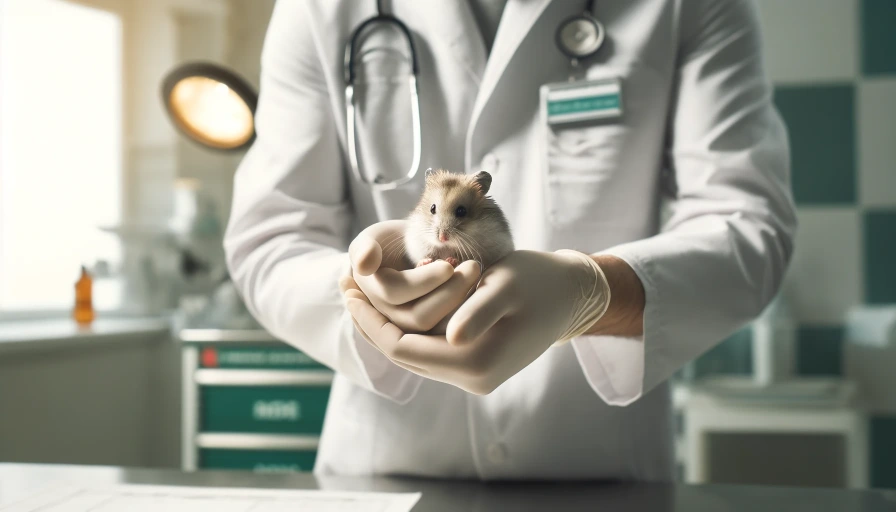
Finding out that your hamster has eaten chocolate can be a scary moment. Don’t panic—there are steps you can take to help your furry friend.
Acting quickly and efficiently can make all the difference.
Step-by-Step Emergency Response
- Remove the Chocolate: If you catch your hamster in the act, immediately take away any remaining chocolate. This prevents them from eating more and helps you estimate how much they’ve consumed.
. - Check for Symptoms: Look for signs of chocolate poisoning. Symptoms can include restlessness, increased heart rate, diarrhea, tremors, and more severe issues like seizures.
. - Contact Your Veterinarian: Call your vet as soon as possible. Explain the situation, including how much chocolate your hamster may have eaten and the symptoms you’ve observed. Your vet can provide guidance on the next steps and may ask you to bring your hamster in for an examination.
. - Follow Vet’s Instructions: Your vet may give you specific instructions to follow before you can get to the clinic. This might include keeping your hamster calm and warm or administering activated charcoal if you have it and if advised by your vet.
When to Contact a Veterinarian
It’s always best to err on the side of caution and contact a vet whenever your hamster consumes something potentially harmful like chocolate.
Even if your hamster seems fine initially, symptoms can develop later. Prompt veterinary advice is crucial.
Home Remedies vs Professional Treatment
While waiting for professional help, there are a few things you can do to keep your hamster comfortable:
- Hydration: Ensure your hamster has access to fresh water. Dehydration can worsen the effects of poisoning, so it’s important they stay hydrated.
- Calm Environment: Keep your hamster in a quiet, comfortable area away from loud noises and stress. A calm environment can help reduce stress and agitation.
However, it’s important to remember that home remedies are not a substitute for professional veterinary care. Your vet has the expertise and resources to provide the best possible treatment for your hamster.
In conclusion, if your hamster eats chocolate, act quickly to remove the chocolate, check for symptoms, and contact your veterinarian immediately.
By staying calm and following these steps, you can help protect your hamster from the dangers of chocolate poisoning.
Safe Treat Alternatives for Hamsters
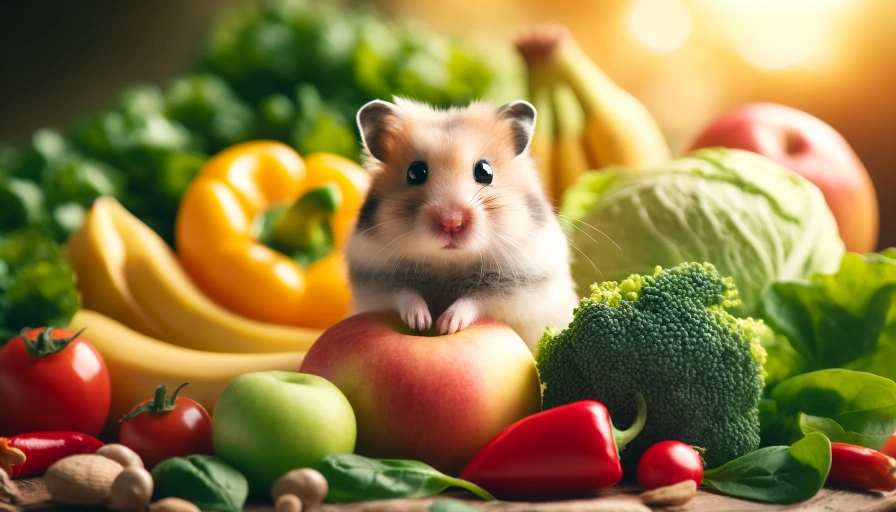
Instead of chocolate, which is dangerous for hamsters, there are plenty of safe and healthy treat options that your hamster will love.
Providing a variety of nutritious treats can keep your hamster happy and healthy. Let’s explore some great alternatives.
Fruits and Vegetables
Fresh fruits and vegetables can be a wonderful treat for your hamster. They provide essential vitamins and minerals, adding variety to their diet.
- Safe Fruits: Apples (without seeds), bananas, blueberries, strawberries, and melons. Make sure to wash the fruits thoroughly and cut them into small, manageable pieces.
- Safe Vegetables: Carrots, cucumbers, bell peppers, broccoli, and spinach. Again, always wash the vegetables and cut them into bite-sized pieces to make them easy for your hamster to eat.
These fruits and vegetables not only offer nutritional benefits but also help keep your hamster hydrated. However, remember to introduce new foods gradually and in small amounts to avoid digestive issues.
Commercial Hamster Treats
There are many commercial treats available that are specifically formulated for hamsters. These treats are designed to be safe and nutritious, providing a balanced addition to their regular diet.
- Recommended Brands: Look for reputable brands that use high-quality ingredients. Some popular options include Oxbow, Kaytee, and Vitakraft.
. - Ingredients to Look For and Avoid: When choosing commercial treats, check the ingredient list. Opt for treats with natural ingredients and avoid those with added sugars, artificial colors, or preservatives. Ingredients like sunflower seeds, pumpkin seeds, and dried fruits are usually good choices.
Homemade Treats
If you enjoy a bit of DIY, you can make homemade treats for your hamster. Simple recipes using safe ingredients can be a fun way to spoil your pet.
- Oat and Honey Balls: Mix oats with a small amount of honey and form into tiny balls. Let them dry out before offering them to your hamster. These should be given sparingly due to the honey.
. - Veggie Chips: Thinly slice safe vegetables like carrots or sweet potatoes, bake them until crisp, and let them cool. These crunchy treats can be a hit with your hamster.
Nutritional Benefits of These Treats
Providing a variety of safe treats can help ensure your hamster gets a range of nutrients. Fruits and vegetables are rich in vitamins and minerals, while seeds and nuts offer healthy fats and proteins.
Commercial treats, when chosen carefully, can provide balanced nutrition without the risk of harmful additives.
Tips on Introducing New Foods
When introducing new treats to your hamster’s diet, it’s important to do so gradually:
- Start Small: Offer a tiny piece of the new treat and observe your hamster’s reaction. Check for any signs of digestive upset, such as diarrhea or changes in behavior.
. - Monitor Health: If your hamster enjoys the treat and shows no adverse effects, you can gradually increase the amount. Always keep an eye on their overall health and well-being.
. - Variety is Key: Mix up the treats to keep things interesting for your hamster. A varied diet can help prevent boredom and ensure they receive a wide range of nutrients.
By providing safe and nutritious treats, you can keep your hamster happy and healthy without the risks associated with chocolate.
Treat time can be a fun and rewarding part of your hamster’s day, strengthening your bond and contributing to their overall well-being.
Preventing Accidental Chocolate Ingestion
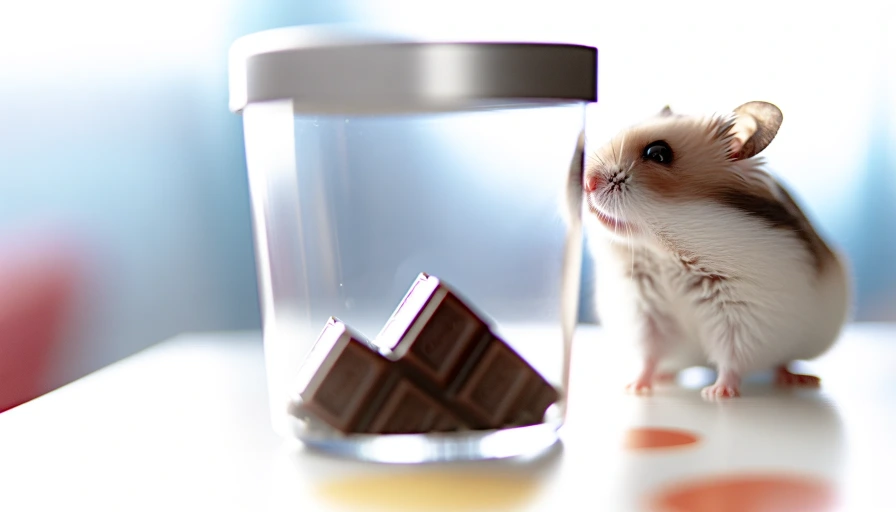
Ensuring your hamster never gets its paws on chocolate is crucial for its health and safety.
Here are some practical tips to help prevent accidental chocolate ingestion and keep your furry friend safe.
Tips on Hamster-Proofing Your Home
Hamster-proofing your home is the first step to prevent accidental chocolate ingestion. Here’s how you can do it:
- Keep Food Out of Reach: Store all chocolate and chocolate-containing products in places your hamster cannot access. High shelves or closed cabinets work best.
. - Secure Your Hamster’s Cage: Ensure that your hamster’s cage is secure and that it cannot escape. Hamsters are clever and curious, and they can find their way into unexpected places.
. - Monitor Playtime: When your hamster is out of its cage for playtime, supervise closely. Make sure there’s no chocolate or other harmful foods within reach.
Storing Chocolate and Other Harmful Foods Safely
Proper storage of chocolate and other harmful foods is essential to keep them away from your hamster:
- Use Sealed Containers: Store chocolate in sealed containers that are difficult for your hamster to open. This also helps keep the chocolate fresh and away from pests.
. - Designate a Safe Zone: Have a specific area in your home where you handle and store chocolate. Make sure this area is off-limits to your hamster.
. - Educate Family Members: Ensure everyone in your household knows the risks of chocolate for hamsters. Make it a rule that chocolate is never to be left out in areas where the hamster can access.
Educating Family Members About Hamster Safety
Educating everyone in the household about hamster safety is key to preventing accidental ingestion:
- Discuss the Risks: Have a family meeting to discuss the dangers of chocolate and other harmful foods for hamsters. Make sure everyone understands the potential consequences.
. - Create Awareness: Post reminders near your hamster’s cage and food storage areas to keep harmful foods out of reach. This can help everyone remember to be cautious.
. - Involve Kids in Pet Care: If you have children, teach them how to safely handle and care for the hamster. Encourage them to be responsible and mindful about what they feed their pet.
Regularly Check Your Hamster’s Environment
Regularly checking your hamster’s environment can help ensure it remains safe:
- Inspect the Cage: Regularly inspect your hamster’s cage for any signs of damage or potential escape routes. Fix any issues immediately.
- Clean Play Areas: Before letting your hamster play outside its cage, thoroughly check the area for any hidden chocolate or other harmful foods.
- Maintain Cleanliness: Keep your home clean and free of food debris. This reduces the risk of your hamster finding something it shouldn’t eat.
By taking these preventive measures, you can significantly reduce the risk of your hamster accidentally ingesting chocolate.
Keeping a close eye on your hamster and ensuring that everyone in the household is aware of the dangers will help keep your furry friend safe and healthy.
Remember, prevention is always better than dealing with the consequences of chocolate poisoning.
Conclusion
In summary, while hamsters are delightful pets that bring joy to many households, their dietary needs are quite specific.
Chocolate, a treat many of us love, is extremely dangerous for these small creatures. Theobromine and caffeine, the toxic compounds found in chocolate, can cause severe health issues for hamsters, leading to symptoms like restlessness, tremors, seizures, and even death.
It’s essential to be vigilant about what your hamster eats and to ensure that chocolate and other harmful foods are kept well out of their reach.
By understanding the signs of chocolate poisoning and knowing how to respond, you can act quickly if your hamster ever consumes something it shouldn’t.
Instead of chocolate, there are plenty of safe and healthy treats you can offer your hamster.
Fresh fruits, vegetables, and specially formulated commercial treats are excellent options that provide the nutrients your hamster needs.
Introducing these treats gradually and monitoring your pet’s health will ensure they remain happy and healthy.
Preventing accidental chocolate ingestion involves not only keeping chocolate away from your hamster but also educating everyone in your household about the dangers.
By taking simple precautions, you can create a safe environment for your furry friend.
Remember, a little caution goes a long way in ensuring your hamster’s well-being. Providing a balanced diet and safe treats, along with a secure and chocolate-free environment, will help your hamster live a long, healthy, and happy life.
Thank you for taking the time to learn about the importance of hamster diet safety. Your furry friend is lucky to have a caring and informed owner like you!
Frequently Asked Questions
Q: How much chocolate will kill a hamster?
Any amount of chocolate can be potentially lethal for hamsters due to the presence of theobromine, which hamsters cannot metabolize effectively. Even small amounts can lead to poisoning.
Q: Can hamsters eat chocolate chips?
No, hamsters should not eat chocolate chips or any form of chocolate as it is toxic to them and can cause serious health problems.
Q: Can hamsters eat chocolate cake?
No, hamsters should not eat chocolate cake. Chocolate is toxic to hamsters, and the sugar and fat in cakes can also be harmful to their health.
Q: Can hamsters eat chocolate ice cream?
No, hamsters should not eat chocolate ice cream. Chocolate is toxic to them, and dairy products are also not recommended for hamsters as they can cause digestive issues.
Q: Can hamsters eat white chocolate?
While white chocolate contains less theobromine than darker chocolates, it is still unsafe for hamsters. It is high in sugars and fats, which are unhealthy for hamsters.
Q: What do I do if my hamster eats chocolate?
If your hamster eats chocolate, it’s important to seek immediate veterinary care. The vet may administer treatments to help minimize the absorption of toxins and support your hamster’s recovery.

